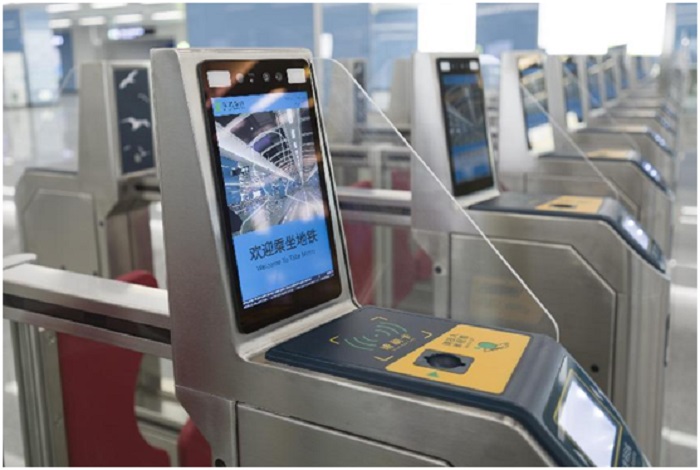



As China pushes ahead with the construction of smart cities, smart subway has gained momentum across the country, with big data, cloud computing, artificial intelligence (AI), 5G and other new technologies being increasingly employed in urban rail transit systems.
Thanks to digital technologies, subways in China are not only able to function as a convenient and fast means of transportation, but meet people’s diverse needs and offer a wide range of services.
Lushuidao Station along Metro Line 6 (Phase 2) in north China’s Tianjin municipality was designed to perform 20 functions based on smart technologies, including intelligent passenger services, passenger flow heat mapping, automatic control of various systems and equipment, as well as smart lighting.
Through a comprehensive operation platform at the central control room of the station, workers are able to monitor the entire station and spot various incidents in time.
Sensors installed in the station can gather data on carbon dioxide, sulfur dioxide, temperature, humidity and fine particulate matter (PM 2.5) 24 hours a day; and intelligent ambient lighting and interconnected air and water systems for central air conditioning can effectively save electricity and improve energy management efficiency.
Besides, trains running on the Metro Line 6 (Phase 2), Tianjin’s first fully-automated subway line, can automatically awaken various systems, depart and begin daily operation, carry out the passengers, return to the garage and switch to sleep mode, detect obstacles, and issue forward collision warning, etc.
At Guoduxi Station of Metro Line 6 in Xi’an, capital of northwest China’s Shaanxi province, an AI-based virtual “attendant” serving as an information assistant with a human voice and communication skills enables passengers to search for information.
Passengers can interact with the virtual “attendant” either through the use of a touch screen or voice commands. The “attendant” can automatically judge the needs of passengers according to their questions, and guide them to the right service interfaces.
Xi’an Metro Line 6 is the first of its kind in China that has adopted a smart security check system for the whole line, which, empowered by technologies concerning such tasks as intelligent identification, smart image analysis and intelligent connection, can ensure that passengers and their personal belongings go through security checks efficiently.
After registering an account on Guangzhou Metro’s official app with their authentic identity information, passengers can make use of a facial recognition system to board and pay fares without fumbling for a transportation card at stations of Metro Line 18 in Guangzhou, capital city of south China’s Guangdong province.
During rush hours, the app, as well as the public address system, electronic screens, and escalators at stations, display the real-time crowd levels of carriages to guide passengers to those with lower crowd density.
Since the outbreak of COVID-19, subway has become a major front line for the containment of the epidemic.
Subways in various cities across China rolled out diversified smart systems to ensure people’s safety amid large flows of population, making positive contributions to epidemic control. The urban rail transport system in Shenzhen city, Guangdong province, has employed a smart system for security checks that enables information about high fevers and other abnormalities to be sent to the subway command center as fast as possible.
Fuzhou Metro in Fuzhou, southeast China’s Fujian province, has deployed intelligent thermal cameras that can automatically measure and record passengers’ body temperature, helping avoid close contact while enabling passengers to enter the subway stations more efficiently.
Some subway stations offer passengers exciting cultural experiences. In Changsha, capital of central China’s Hunan province, a digital art museum covering an area of 2,000 square meters was inaugurated in an interchange station of the city’s subway system.
The museum, the first of its kind in the country, includes six large-scale three-dimensional LED art installations, which transform part of the metro station into an art space, showcasing a blend of science, technology, and fashion.
“With the rapid development of smart metro systems, both the core function as a means of transportation and additional functions of the metro can be realized through the application of digital and intelligent technologies,” said Wang Peng, an associate professor at Renmin University of China.
The integration of intelligent technologies and applications into metro systems, a transportation means closely related to people’s everyday life, has brought more convenience to passengers, Wang noted.
At the same time, subways have created more new application scenarios for digital technologies in aspects such as relaxation, culture, tourism, advertising, and social contact, playing a big role in promoting cultural communication and business ecosystem development, he added.


The Humanitarian Service Diamond Awards has.
A Chinese Company, Inner Galaxy Steel.


The Programme Coordinator, Regulatory, Compliance and.


A Non-Governmental Organization (NGO), Committee for.
The Trustfund Pensions Limited has chided.


The House of Representatives Committee on.
The China General Chamber of Commerce.


Senator Chuka Utazi who represented Enugu.


An Abuja based Legal Practitioner, Ugochukwu.


The African business community in Yiwu,.
Leave a Comment